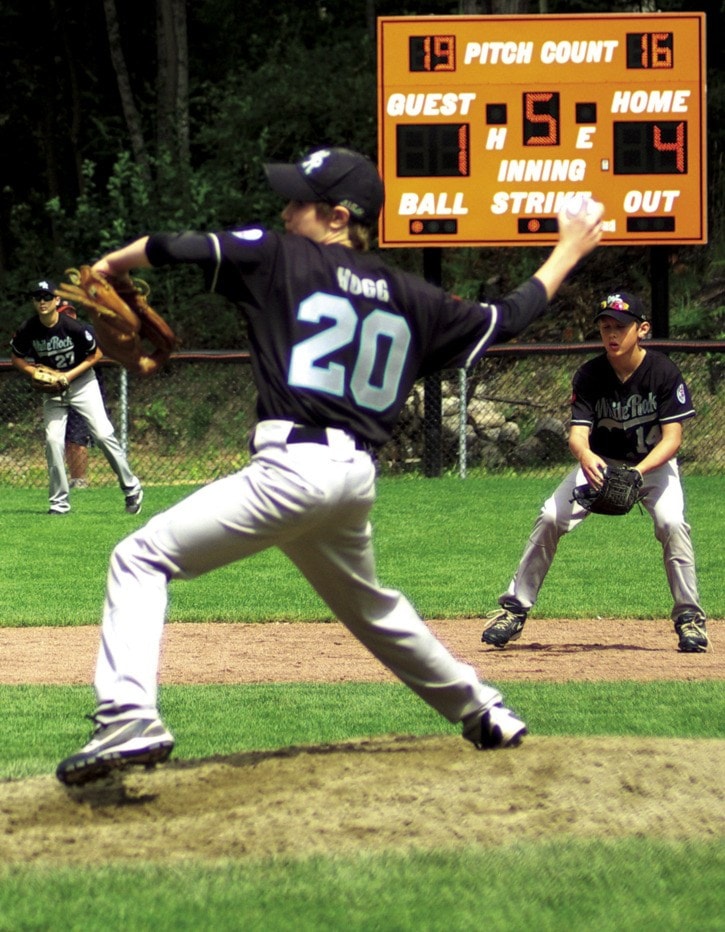While everyone has been enjoying the great baseball being played at the B.C. Little League Championships at Andy Bilesky Park, there have been murmurs of dismay at one rule (maybe two) that flummoxes some baseball fans, umpires, scorekeepers, coaches and players – the pitch count.
Since 2008, stricter pitching regulations have changed the way Little League teams approach the game.
Coaches often call timeout to check the official pitch count, and when a pitching change is instituted, a pitcher is given time to warm up - something that can happen a couple times every inning - drastically impeding the pace of the game.
It is a rule, says umpire Bill MacMillan that is “legislated integrity” – it looks good on paper, but is sorely lacking when applied to the game.
“It’s more of a mandatory rest rule than a pitch count rule,” he added. “I did the plate on the first game of the tournament and we did the first two innings in 20 minutes, and the total game time was two-hours-18-minutes.”
Between pitching, position, and runner substitutions MacMillan had close to 40 changes on his lineup card as opposed to four at a recent senior mens baseball game.
“It’s overly micromanaged at this level of ball. There’s no flow in the game.”
The changes to the rule were implemented after a 2007 American Medical Institute study on young pitchers showed that overuse resulted in increasing pitching injuries.
As a result, Little League organizations everywhere in North America adopted new pitching regulations to extend the period of rest in relation to number of pitches thrown, exacerbating the affect of rules on playing time and seemingly unlimited substitutions.
“All these teams use to carry 15 players and then they mandated that each player had to play a certain number of defensive innings or a certain number of at bats, but the immediate response of the coach was drop the roster to 12 players . . . the intent of the rule was to get all kids playing, the effect of the rule was that three kids on every team don’t play at all . . . The intent was good but nobody really thought out the effect.”
Previously, a 12-year-old pitcher in the regular season who threw the maximum 85 pitches in a day was required to have either three-calendar days of rest and one game (or four days of rest and no game, at the option of the local league), before pitching again. With the new rules, that same pitcher will simply be required to have four days of rest.
“I think honestly, it promotes blow-outs,” said host-committee member and scorekeeper Corey Ross. “Quickly 10-run them and I don’t have to use pitching. There seem to be a lot more mercy rule type games now than when I played.”
Ross is all for protecting young arms, but he also makes a salient criticism of the rule’s umbrella affect.
Every pitcher is different. A pitcher with good mechanics, who throws mainly fastballs is at much lower risk of injury than one with poor technique or a pitcher throwing curve balls all day.
“They are just ensuring that kids aren’t getting hurt, which is totally understandable . . . I understand the concept, it’s to protect the kids, but it (the pitch count) is a little low for me.”
It also makes the coaches’ job a lot tougher. Coaching staff now has to carry a team loaded with pitchers and must keep a close eye on the pitch count as well as the number of substitutions and who has played the required amount. Even more difficult, is planning for upcoming games.
“In a tournament like ours, without any days off in between we have to be really smart on how we use our pitching, and I think our philosophy is to use the 20-20-20 kind of thing, but if a kid is doing really good, do we go with him, but he is now potentially burned for three or four days? So that’s the potential worry for any coaches. You have to make sure you have your best pitching left over to help you get through the semis and finals. It’s a hard thing to think about, but its’ that important.”
